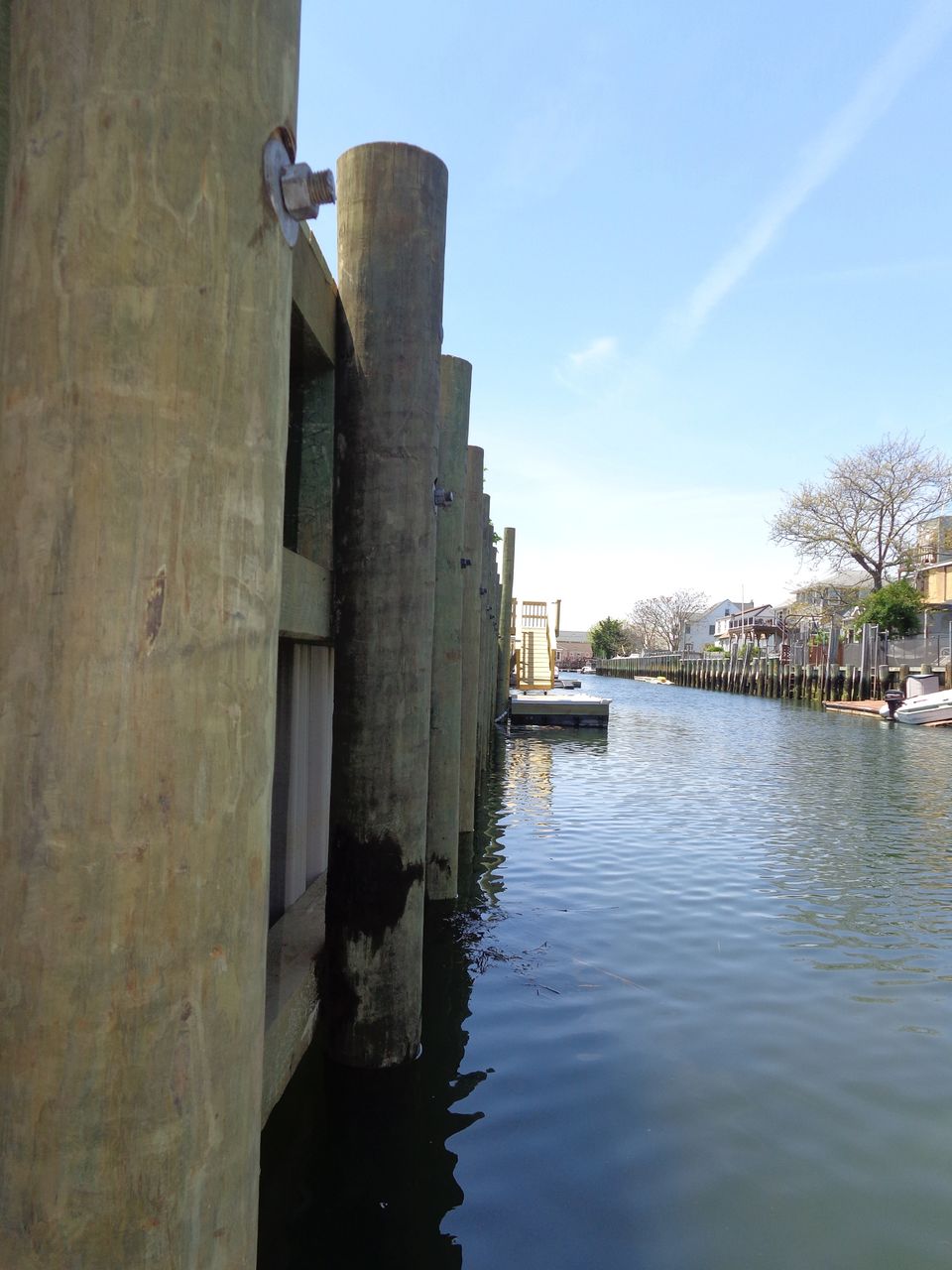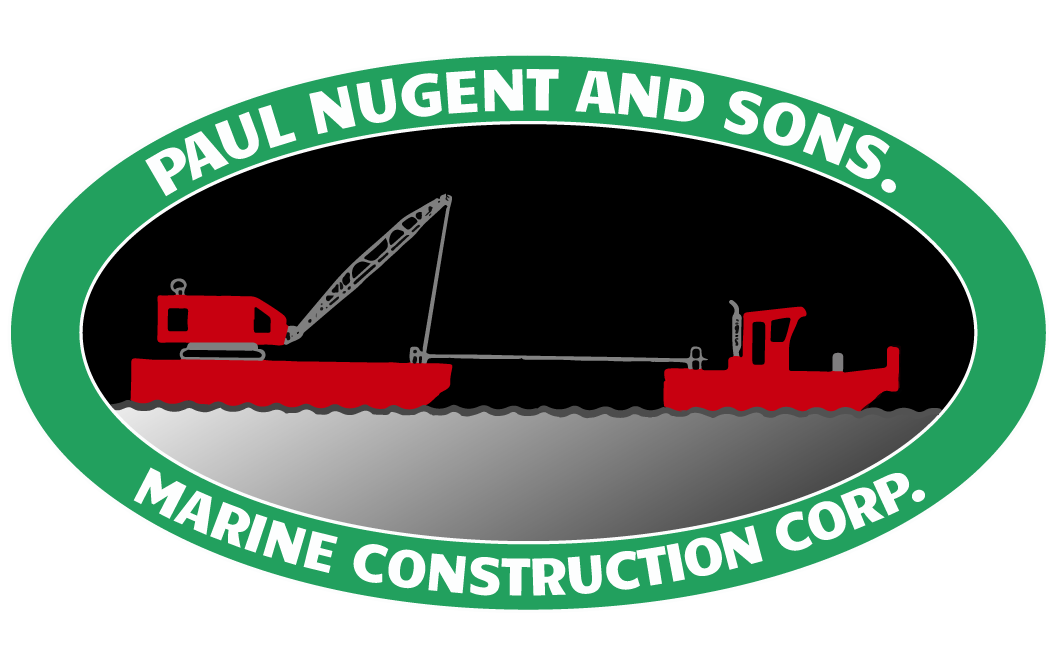
Our Process


Our attention to detail is evident in every step in the building process.
OBTAINING A PERMIT:
We can do that for you.
SITE PREPARATION:
Our equipment is brought to your site through the water on barges. The process begins with removing your existing bulkhead and stockpiling your old ramps or floats if they are to be reconstructed. Debris is removed using our barges and cleared away from the water side, thus reducing the damage to the front of your property.
FRAMING:
Our framing is done with 12' diameter poles and three 6' or 8' whalers. The poles are from 25 to 35 feet in length, and are set into the mud 10 to 12 feet depending upon strength requirements for circumstances such as adding a pool. First the soil is loosened by a process called jetting. The poles are dropped in place by a crane and hammered into the mud by a 1500 lb. weight that moves through a shaft called a lead, applying pressure on an exact point. Here again, accuracy is important. Setting poles to this depth assures that your bulkhead will never shift or settle.
WHALERS:
Our whalers are massive treated wooden crossbars installed onto the poles that will bear the weight of the bulkhead. Nothing less than 3 whalers are adequate for withstanding the hydraulic pressure the bulkhead will have to resist. The top whaler is set with a transit and bolted to the poles with a large timber bolt passing through the whaler and the pole. The other two whalers below are installed parallel. Accuracy here is critical. The whalers are the cross bars that you see on the finished bulkhead.
SHEATHING:
We use a vinyl product that is co-extruded vinyl and a vinyl laminate. It is impervious to worms and UV damage. The interlocking C-lock cannot separate and will not leak like a wood tongue-and-groove installation. The sheathing material is installed behind the whalers. Water pressure is used to create a trench by blowing the soil out of the area. The pole sections are lowered by crane, hand guided, and mechanically driven down into the underwater soil and locked into place.
DEAD LOGS:
The dead logs are shorter pieces of poles. They are set behind the bulkhead poles back about 15 feet and parallel to the bulkhead. Tie rods are rods that are actually 15 foot bolts that pass through the bulkhead pole, the sheathing and the dead log. Recycled sheathing is installed between the poles adding even more support. Afterwards this structure is covered with soil and becomes invisible. The dead log system stabilizes the structure when there is unequal pressure as there can be during a hurricane when the water flows over the top of the bulkhead.
SHEET RETURNS:
The sheet returns are structures run back along the sides of your property line at both ends of your seawall and protect your soil from caving in should your neighbor’s bulkhead be in trouble or need rebuilding. Real protection comes only with a full size top whaler and full length sheeting that extends back at least 6 feet. The possibility of losing your landscaping at some point is eliminated with this process.
BACK FILLING:
Sometimes a job requires extra soil trucked in and especially so if the level of your yard needs to be elevated. Our bobcat does the spreading and the surface will be graded and readied for your landscaper.
BOARDWALKS:
Boardwalks are usually built along the edge of the wall to cover the holes from the C-Lock sheathing. They can be narrow, sometimes just 24” or wide enough to include a deck.
We can do that for you.
SITE PREPARATION:
Our equipment is brought to your site through the water on barges. The process begins with removing your existing bulkhead and stockpiling your old ramps or floats if they are to be reconstructed. Debris is removed using our barges and cleared away from the water side, thus reducing the damage to the front of your property.
FRAMING:
Our framing is done with 12' diameter poles and three 6' or 8' whalers. The poles are from 25 to 35 feet in length, and are set into the mud 10 to 12 feet depending upon strength requirements for circumstances such as adding a pool. First the soil is loosened by a process called jetting. The poles are dropped in place by a crane and hammered into the mud by a 1500 lb. weight that moves through a shaft called a lead, applying pressure on an exact point. Here again, accuracy is important. Setting poles to this depth assures that your bulkhead will never shift or settle.
WHALERS:
Our whalers are massive treated wooden crossbars installed onto the poles that will bear the weight of the bulkhead. Nothing less than 3 whalers are adequate for withstanding the hydraulic pressure the bulkhead will have to resist. The top whaler is set with a transit and bolted to the poles with a large timber bolt passing through the whaler and the pole. The other two whalers below are installed parallel. Accuracy here is critical. The whalers are the cross bars that you see on the finished bulkhead.
SHEATHING:
We use a vinyl product that is co-extruded vinyl and a vinyl laminate. It is impervious to worms and UV damage. The interlocking C-lock cannot separate and will not leak like a wood tongue-and-groove installation. The sheathing material is installed behind the whalers. Water pressure is used to create a trench by blowing the soil out of the area. The pole sections are lowered by crane, hand guided, and mechanically driven down into the underwater soil and locked into place.
DEAD LOGS:
The dead logs are shorter pieces of poles. They are set behind the bulkhead poles back about 15 feet and parallel to the bulkhead. Tie rods are rods that are actually 15 foot bolts that pass through the bulkhead pole, the sheathing and the dead log. Recycled sheathing is installed between the poles adding even more support. Afterwards this structure is covered with soil and becomes invisible. The dead log system stabilizes the structure when there is unequal pressure as there can be during a hurricane when the water flows over the top of the bulkhead.
SHEET RETURNS:
The sheet returns are structures run back along the sides of your property line at both ends of your seawall and protect your soil from caving in should your neighbor’s bulkhead be in trouble or need rebuilding. Real protection comes only with a full size top whaler and full length sheeting that extends back at least 6 feet. The possibility of losing your landscaping at some point is eliminated with this process.
BACK FILLING:
Sometimes a job requires extra soil trucked in and especially so if the level of your yard needs to be elevated. Our bobcat does the spreading and the surface will be graded and readied for your landscaper.
BOARDWALKS:
Boardwalks are usually built along the edge of the wall to cover the holes from the C-Lock sheathing. They can be narrow, sometimes just 24” or wide enough to include a deck.
“This process builds the strongest deadlog system in the industry” - Paul Nugent II

What We Use
We use only the best materials available
HARDWARE:
We use only galvanized hardware - 10" cleats and 1/2" bolts.
WOOD POLES:
12" diameter poles, 25 to 35 feet in length
WHALERS:
These are the horizontal timbers that you see from the water side. Whalers are special marine lumber treated to 2 1/2 lbs. of CCA retention per cubic foot of lumber. We DO NOT use 1 1/2 lbs. lumber. The top whaler is bolted through to the pole with a large timber bolt which passes through the pole and the whaler.
C-LOCK SHEATHING:
A vinyl product that is co-extruded vinyl and a vinyl laminate. It is impervious to worms and UV damage. the interlocking C-lock cannot separate and will not leak like a wood tongue-and-groove installation. The strength comes from the profile rather than the thickness of the material.
PLASTIC COMPOSITE:
Composites such as Trex or Timber Tech can be used on decks, ramps, floats and boardwalks in place of wood. It is non splintering and longer-lasting than wood, is impervious to UV damage, and requires little or no maintenance.
TIE-BACK ANCHORS or HELICAL SCREW ANCHORS:
These carefully engineered bearing devices are installed when it is impractical to use other methods. Constructed of high tensile metals, they are more expensive than conventional methods, but these anchors work where other solutions can't, such as under pools or structures built close to the bulkhead.
We use only galvanized hardware - 10" cleats and 1/2" bolts.
WOOD POLES:
12" diameter poles, 25 to 35 feet in length
WHALERS:
These are the horizontal timbers that you see from the water side. Whalers are special marine lumber treated to 2 1/2 lbs. of CCA retention per cubic foot of lumber. We DO NOT use 1 1/2 lbs. lumber. The top whaler is bolted through to the pole with a large timber bolt which passes through the pole and the whaler.
C-LOCK SHEATHING:
A vinyl product that is co-extruded vinyl and a vinyl laminate. It is impervious to worms and UV damage. the interlocking C-lock cannot separate and will not leak like a wood tongue-and-groove installation. The strength comes from the profile rather than the thickness of the material.
PLASTIC COMPOSITE:
Composites such as Trex or Timber Tech can be used on decks, ramps, floats and boardwalks in place of wood. It is non splintering and longer-lasting than wood, is impervious to UV damage, and requires little or no maintenance.
TIE-BACK ANCHORS or HELICAL SCREW ANCHORS:
These carefully engineered bearing devices are installed when it is impractical to use other methods. Constructed of high tensile metals, they are more expensive than conventional methods, but these anchors work where other solutions can't, such as under pools or structures built close to the bulkhead.
